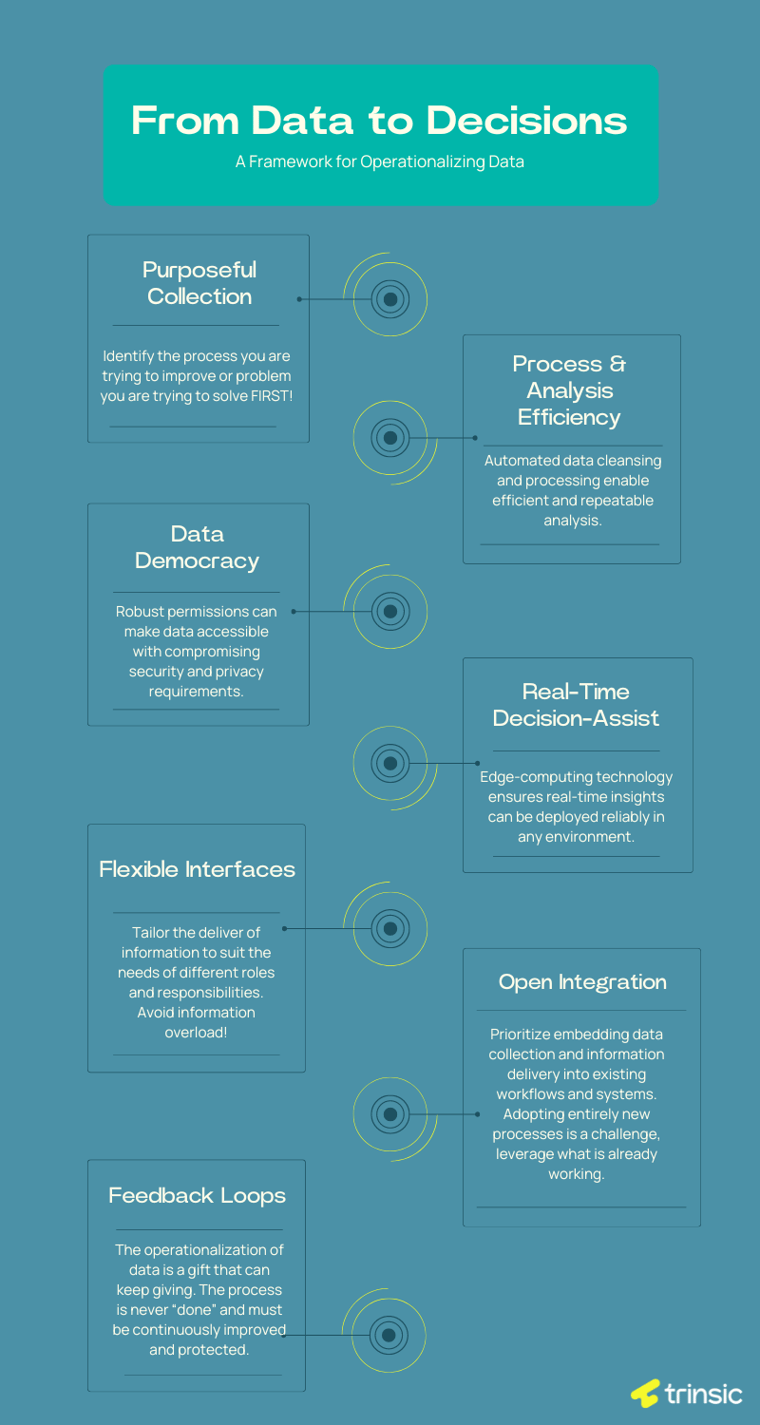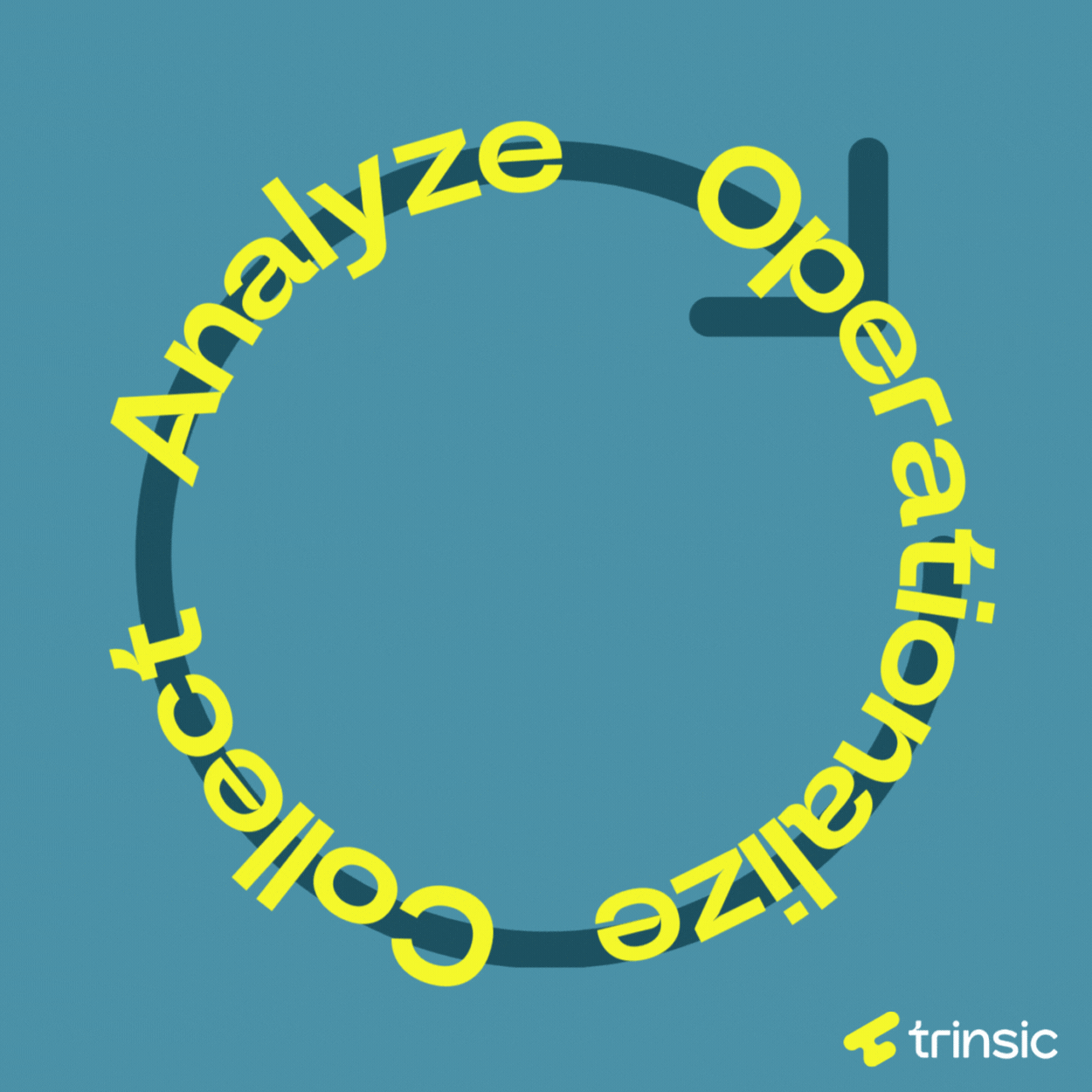October 17, 2023
From Data to Decisions: Operationalizing Data for Real-World Impact
Written by: Trinsic

What We’ll Cover:
- Essence of Operationalizing Data: Discover why operationalizing data is essential in today's data-driven landscape and how it goes beyond mere collection and analysis.
- A Comprehensive Framework: Explore a step-by-step framework that guides you from purposeful data collection to delivering real-time insights and decision assistance.
- Real-World Application: Learn how operationalizing data is implemented through a compelling real-world example.
Show me the summary
In today's data-centric landscape, collecting and analyzing vast amounts of information has become commonplace.
Yet, the real challenge lies in ensuring that this data is not just processed but also transformed into actionable intelligence, insights, and decision assistance when and where it's needed most. This approach moves us beyond the conventional realm of white papers and research studies, allowing data to empower decision-makers at the operational level.
Operationalizing Data: A Holistic Approach
Operationalizing data is about more than just gathering and crunching numbers. It's a comprehensive framework that enables organizations to extract maximum value from their data by making it accessible, relevant, and timely for those who rely on it. The framework below can help you navigate this journey and identify gaps in your current data strategy.
1. Data Collection with Purpose
The journey begins with data collection. But collecting data for the sake of it is futile. Start with a clear purpose. Understand what insights you aim to derive and what decisions you intend to support. Define your data collection strategy accordingly, ensuring your data aligns with your objectives.
2. Efficient Data Processing and Analysis
Once you have your data, processing and analyzing it efficiently is crucial. Data streams should flow uninhibited with automated cleansing and be stored and analyzed with the intent to operationalize. This involves employing advanced analytics to extract meaningful patterns, trends, and insights. The goal here is not to create interesting plots or publications but to transform raw data into actionable information to guide decisions.
3. Democratizing Data Access
Operationalizing data means making it available to the right people. Data platforms can provide robust permissions frameworks to allow relevant stakeholders to access everything from data models and PHI to high-level reports and decision-assist metrics. This accessibility enables sufficient transparency to promote a data-driven culture across the organization. Keep in mind security and compliance requirements that may apply to your environment, such as HIPAA and GDPR.

4. Real-Time Insights
In today's fast-paced world, the value of real-time insights cannot be overstated. Implement systems that provide up-to-the-minute information to support immediate decision-making. Edge-compute capabilities are particularly critical in dynamic industries where remote or disconnected environments are common and rapid decision assistance is optimal.
5. Customization for End Users
Not all insights are relevant to everyone in your organization; in fact, access to too much data or information can inhibit decision-making. Tailor your delivery of information to suit the needs of different users or roles. Flexible and customizable dashboards, reports, and interfaces ensure that decision-makers have the information most relevant to their roles readily available at the right times.
6. Integration with Existing Workflows
To maximize the impact of operationalized data, ensure seamless integration with existing workflows and systems. This initiative should complement and enhance existing processes, not disrupt them. Open integration simplifies decision-making, enabling faster implementation, adoption, and value.
7. Feedback Loops and Continuous Improvement
Operationalizing data is an ongoing process, an investment that needs to be protected. Identify technology partners that seek your input and trust your domain expertise to optimize implementing feedback loops to continuously refine your data collection, analysis, and delivery mechanisms. After all, you are the expert in your organization's needs, workflows, and desired outcomes! Regularly and collaboratively assess the effectiveness of your data-driven decision-making processes and make adjustments as needed.
Empowering Decisions: Collecting and Analyzing vs. Operationalizing
Imagine a Human Performance Optimization (HPO) team responsible for a unit’s warfighter readiness...
They collect performance, troop training, and health data using various processes, tools, and technologies. Decisions are generally made based on individual practitioner expertise and, in some cases, leveraging various data points based on literature and previous internal analyses, enabling the HPO team to adjust training plans or, if necessary, refer the soldier to a specialist.
Once the data is collected, HPO staff manually input it into spreadsheets, diverting their attention from their primary responsibilities and introducing the risk of human error. As data is input, the analysts continuously cleanse it to identify inaccuracies, reformat, and de-duplicate. Once complete, this data is then visualized into a series of simple reports shared with leadership.
However, this lag does not support timely decision-making, potentially disadvantaging the unit. Urgent decisions regarding adjusting training schedules or guiding individual warfighters to specific resources have already been made. Lacking real-time data-driven guidance, Commanders and unit leaders must rely on status quo decision inputs that are more subjective and qualitative.
Given the vast pool of human observation data, analysts work to identify trends and patterns that could impact warfighter readiness. As analysis occurs, trends and insights emerge slowly and retrospectively to identify interesting trends and patterns, though some are no longer relevant. Once the analysis write-up is shared, the results are insightful and valuable. Still, they cannot be leveraged in real time. This lack of agility can affect the unit's ability to respond rapidly to changing conditions.
Based on this latest analysis, some changes are suggested for the next deployment cycle, though there is significant pushback from Unit Leaders who never received the analysis write-up. Debates ensue, and ultimately, changes are made with the condition that the next cycle’s data is also analyzed to see if the change has any overall impact on readiness. The process begins again as the Commander and Unit Leaders eagerly await the expected results in 12-18 months.
Now, imagine the same HPO unit...
They collect performance, troop training, and health data using various processes, tools, and technologies. Data is directly entered into a data platform or by automated sync to ensure it is compiled accurately and rapidly.
The platform uses edge-based advanced analytics to transform data into insights to augment subject matter expertise and support real-time decision-making. These insights are easily and securely accessible to commanders, unit leaders, HPO practitioners, and medical staff through customized interfaces or automated reports, allowing real-time monitoring of readiness and decisions.
Training schedules can be adjusted, interventions can be provided, and individual warfighters can be guided to specific resources using semi-automated processes. These decisions are seamlessly integrated into existing workflows, and information is distributed through existing channels and systems to optimize visibility.
Meanwhile, continuous feedback loops for the individual troops ensure ongoing improvement in readiness efforts, identifying group or deployment cycle trends and insights that can inform high-level decisions. Data analysts can focus on identifying significant trends and patterns that can be deployed directly to decision-makers. HPO practitioners can concentrate on supporting warfighters and contributing expertise to provide context for analyses and new decision-assist modeling. Commanders can objectively assess not only the current readiness of their force but also evaluate longitudinal trends in unit readiness.
This continuous and iterative monitoring helps to improve processes and resource allocation to optimize readiness well into the future.

Investing in Systems, not Solutions
For the sake of pragmatism, it is important to reiterate that getting from merely collecting and analyzing data to completing the loop of operationalizing takes time. This requires intentional steps, purposefully designed processes, and cross-functional alignment. For most organizations, step one of this framework is critical; to truly make data-driven decisions, the path must first be cleared by understanding what questions you are trying to answer, what insights would be meaningful, and what processes or decisions could be improved.
Take Home
- Operationalizing data transforms raw information into actionable intelligence to drive decision-making. It is not data collection and analysis that leads only to white papers and publications.
- By following this framework, organizations can ensure that their data serves a purpose, is readily available to decision-makers, and seamlessly integrates into existing workflows.
- In doing so, they empower their teams to make informed decisions that drive success in an ever-evolving data-driven landscape.
Other posts you might be interested in:
View All Posts
Data
8 min read
| September 13, 2023
Deciphering the Unique Nature and Value of Human Observation Data
Read More
Technology
8 min read
| February 6, 2024
Complete Collection: The Data You See and The Data You Don't
Read More
Technology
15 min read
| November 14, 2023